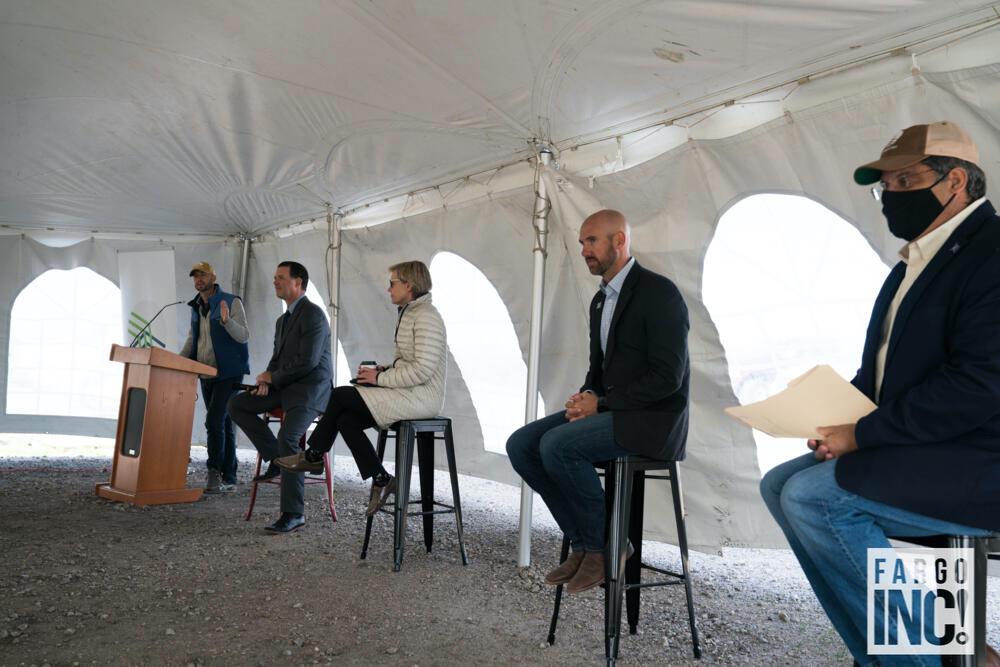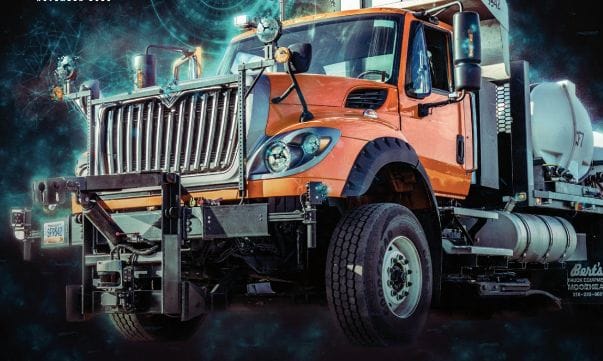Photos by Nolan Schmidt
Self-driving vehicles still seem like a thing more fit for the Jetsons than modern-day life. However, the wave of autonomous systems is already here in our little old prairie and the tide is rising.
On October 8, that rising tide resulted in the North Dakota Department of Transportation unveiling an autonomous Truck Mounted Attenuator (TMA) at Grand Farm Innovation Days. The truck was developed in a partnership with Kratos Defense & Security Solutions in an effort to save lives.
Currently, TMAs are human-driven mobile crash barriers that follow behind a highway maintenance vehicle to protect workers and equipment from potential collisions. This puts the drivers of TMAs at risk themselves.
*According to the Federal Highway Administration
Work Zones 2015
- Crash every 5.4 minutes
- 70 crash-related injuries daily
- 12 crash-related fatalities weekly
The autonomous TMA will almost completely mitigate the crash-related injuries and fatalities that currently are the result of these work zone crashes that are, unfortunately, inevitable. The autonomous TMA works by precisely following the manned lead truck in front of it, adding a level of protection for those individuals as well.

The Partnership With Kratos Defense & Security Solutions

The partnership with Kratos Defense & Security Solutions is one of the main reasons for the success of the project to date. Kratos Defense is a multibillion-dollar company located out of San Diego California that specializes in supplying unmanned systems, satellite communications, cybersecurity/warfare, microwave electronics, missile defense, hypersonic systems, training and combat systems to United States National Security related customers, allies and commercial enterprises.
With a focus on national security technologies, it might surprise you that this isn’t Kratos’ first step into the transportation space. In fact, their autonomous TMAs are in various stages of approval for deployment as standard equipment in live mobile highway work zone operations in England and five other states. And, the system is already being deployed and is approved statewide by the Colorado Department of Transportation.
The system is not currently approved for use in North Dakota. Kratos is still working to “harden” the system for our harsh winters which can cause interference with the vehicle-mounted external sensors due to our extensive snow and ice conditions. Kratos is also working closely with the men on the road to improve the system through feedback.
“It is as easy as them just giving me a call or shooting me a text,” said Vice President of Business Development Maynard Factor. “We have been supporting all ATMA customers with various updates and system enhancements since the beginning.”
According to the NDDOT, their staff learned about the autonomous TMA through technology and transportation conferences. “It is great when military technology can be adapted for civilian use.Especially when it has the potential such as this to save lives,” said Director of the Department of Transportation William Panos.
“This is important because this truck will save lives and help prevent serious crash injuries to workers in construction zones,” said Panos. “NDDOT is committed to using innovation and technology to improve safety and operations throughout North Dakota.”

The gathering at the Grand Farm for Innovation Days wasn’t only to unveil the autonomous truck. The gathering also served as an opportunity for experts from different walks of life to gather and talk about all things autonomous. The three panels at the event included:
Industry Panel:
- Tim Mahoney – Mayor, City of Fargo
- Joel Honeyman – Vice President of Global Innovation, Doosan Bobcat
- Tommy Kenville – President/CEO, ISight
- Terri Zimmerman – CEO, Packet Digital and Botlink
- Maynard Factor – Vice President Business Development, Kratos Defense
Research
- Mark Haggerott – Chancellor, North Dakota University System
- Jane Schuh – Vice President of Research and Creative Activity, NDSU
- Mark Askelson – Professor of Atmospheric Sciences, UND
Policy
- John Hoeven, United States Senator
- Nick Flom – Executive Director, Northern Plains UAS Test Site
- Bill Panos – Director, North Dakota Department of Transportation
- Joel Paulsen – Executive Director, FM Area Diversion Project
- Cindy Schreiber-Beck – North Dakota House of Representatives
“It seems a little unlikely that a flood control program would be involved with automation… But, we will be responsible for 17,000 acres of maintenance. That maintenance will have to be done to the specifications of federal environmental law, the core of engineers and the political jurisdictions that we impact, affect and benefit. Automation is a huge part of that. The ability to have automated mowing operations could potentially save the taxpayers significant dollars on maintenance activities.”
Bonus Q&A With Joel Honeyman, Vice President of Global Innovation at Doosan Bobcat

Bobcat ended the Innovation Days event by showing off one of their newest products, a remote control loader. We sat down with their Executive Director, Joel Honeyman, to learn about the direction that Bobcat is heading.
What can you tell us about the remote control loader that was introduced at Innovation Days?
The loader we showed was equipped with the MaxControl Remote Control option. This is a simple box that connects to the back of the machine and then enables the use of a simple iOS remote control from an iPhone or iPad. This allows the user to then remotely control any function of the machine — drive, lift and tilt of the work group, engine speed, and the use of any work attachment on the machine utilizing the developed iOS app. The control box (hardware) can be plugged into any Bobcat branded loader equipped with selectable joystick controls — all the way back to 2004. This means we can apply today’s latest technology to a piece of equipment manufactured as many as 15 years ago.
Why is it important for Bobcat to get involved in the autonomous space?
In our view, we are defining autonomy more practically around the development of the next set of technology solutions for our customers to be more productive on the job site. Many of these like MaxControl are the building blocks of potentially autonomous operations, but we feel very strongly that these technology solutions will provide benefits for operators even while inside the cab of their machines.
Where are things going for Bobcat within the autonomous space?
We have a number of items under development to support our long-term autonomy strategy. The first of which is the ability to precisely map the features of a job site such as obstacles to avoid and areas not to cross. We then have the ability to send those features to the machine and in its avoidance mode, the machine will stop and not hit them. Those same set of points can also be used as navigational points to mark a boundary such as a virtual curb that the machine can navigate along or a virtual wall to not drive through. We are also developing a full suite of different sensor technologies to detect and avoid unknown objects on the job site and have our machines avoid them. The combination of all these technologies are building blocks that will help enable our customers to be more productive on the job site.
Bonus Interview With Marlo Anderson, the Guru of Geek

Marlo Anderson, founder of the National Day Calendar and host of The Tech Ranch, has been publicly involved in the autonomous space since 2014 when he announced his intentions to create the Autonomous Friendly Corridor. The Autonomous Friendly Corridor, which has since been discontinued, was slated to use U.S. Highway 83 (which runs through North Dakota, South Dakota, Nebraska, Kansas, Oklahoma and Texas, crossing the border into Canada and Mexico) as a major stomping ground for autonomous vehicles.
Although Anderson is no longer pursuing the creation of the Autonomous Friendly Corridor along U.S. Highway 83, he remains extremely passionate about driverless vehicles, having ridden in over 30 different models.
“There are so many benefits once you get past the fear of having someone else drive you. It can help with time management and it can also help with safety.”
According to the National Highway Traffic Safety Administration, 36,560 people were killed in traffic crashes in the United States in 2018. Proponents of driverless cars believe that these numbers should drop sharply when autonomous vehicles are rolled out on a national level due to decreases in human error.
“The only job the vehicle has is to move you from point A to point B,” said Anderson. “The technology already exists and is getting better all the time as processing speeds get faster. 5G is going to be a huge player in this because of the ability for vehicles to communicate faster with each other.”
Anderson is also quick to note that we’re not that far away from the Jetsons era.
“We might actually, in the next three to five years, have the option between a traditional care and a flying car when we go to the car dealership,” said Anderson. “I’ve been in a flying vehicle before and the interesting thing is that there’s not as much regulation in the air, but there isn’t as many. You don’t have to worry about deer or icy conditions or all of the crazy things that you have to worry about when you’re on a road. You may have some other issues but not as much.”








